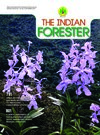Invasive Alien Flora of Sathyamangalam Tiger Reserve in Southern Eastern Ghats, India
DOI:
https://doi.org/10.36808/if/2018/v144i9/116983Keywords:
Invasive Alien Species, Lantana camara, Prosopis juliflora, Eastern Ghats.Abstract
The survey was undertaken to document the invasive alien species distributed in Sathyamangalam Tiger Reserve, Eastern Ghats during November 2014 to November 2016. A total of 107 invasive alien plant species were recorded which belonged to 39 families and 82 genera. Asteraceae formed the most dominant family with 16 invasive alien species, followed by Amaranthaceae (8) and Fabaceae (7). Life-form wise, herbs were the major forms (73.83%) among the invasive alien species. Phytogeographical analysis revealed that species of Tropical American origin formed a major proportion (59.43%) of the invasive alien species in the study area. Monitoring and control of the spread of Prosopis juliflora and Lantana camara is required.
References
Divakara B.N., Prasad S. and Das R. (2013). Documentation of Invasive plants in Lateher and Hazaribagh Districts: Jharkhand – India. Indian Forester, 141 (11):1171–1175.
Gamble J.S. (1915-1936). Flora of Presidency of Madras. 3 Vols. Adlard & Sons Ltd., London.
Haung Q.Q., Wu J.M., Bai Y.Y., Zhou L. and Wang G.X. (2009). Identifying the most noxious invasive plants in China: role of geographical origin, life and means of introduction. Biodiversity and Conservation, 18:265–305.
Henry A.N., Kumari G.R. and Chitra V. (1987). Flora of Tamil Nadu, India. Ser. 1: Analysis. Vol. 2. Botanical Survey of India, Coimbatore.
Hooker J.D.(1872-1897). The flora of British India, Vols. 1-7. Reeve & Co., London.
ILDIS (2007). International Legume Database and Information Service. Reading, UK: School of Plant Sciences, University of Reading. http://www.ildis.org/
Kushalapa K.A. (1991). ACIAR Proceeding series 35:189-193. In: Advances in tropical Acacia research. Proceedings of an international workshop held in Bangkok, Thailand, 11-15 February 1991.
Maheshwari J.K. (1960). The origin and distribution of the naturalized plants of Khandwa Platau, Madhya Pradesh. J. Biological Science, 3:9–19.
Matthew K.M. (1983). The Flora of Tamil Nadu Carnatic, Vol. 3 (part 1-3). The Rapinat Herbarium, St. Joseph's College, Tiruchirappalli.
McGeoch M.A., Butchart S.H.M., Spear D., Marais E., Kleynhans E.J., Symes A., Chanson J. and Hoffmann M. (2010). Global indicators of Biological Invasion: Species Numbers, Biodiversity Impact and Policy Responses. Diversity and Distributions, 16 (1):95–108. doi:10.1111/j.1472-4642.2009.00633.x.
Naidu M.T., Kumar O.A. and Venkaiah M. (2015). Invasive alien species in tropical forests of Eastern Ghats in Northern Andhra Pradesh, India. Indian Forester, 141 (4):428–432.
Nair N.C. and Henry A.N. (1983). Flora of Tamil Nadu, India, Ser. 1-3: Analysis Vol. 1. Botanical Survey of India, Coimbatore.
Pant H.M. and Sharma N. (2010). Inventory of some exotic cultivated tree species of Doon Valley and their ethnobotanical Uses. J. Medicinal Plants Research, 4 (20):2144–2147.
Pullaiah T. and Ramamurthy S.K. (2003). Flora of Eastern Ghats: Hill ranges of South East India Vol. 2. Regency Publications. New Delhi.
Pullaiah T. and Rao M.D. (2002). Flora of Eastern Ghats: Hill ranges of South East India. Vol. 1. Regency Publications. New Delhi.
Pullaiah T., Ramamurthy S.K. and Karuppusamy S. (2007). Flora of Eastern Ghats: Hill ranges of South East India. Vol. 3. Regency Publications, New Delhi.
Pullaiah T., Rani S.S. and Karuppusamy S. (2010). Flora of Eastern Ghats: Hill ranges of South East India. Vol. 4. Regency Publications, New Delhi.
Raizda M.B. and Chatterji R.N. (1954). A diagnostic key to the various forms of introduced Mesquite (Prosopis juliflora DC). Indian Forester, 80: 675-680.
Rao P.R. and Murugan R. (2006). Impact of exotic adventives weeds on Native biodiversity in India: Implications for conservation. In: Invasive alien species and biodiversity in India (Eds. Rai L.C and Gour J.P), Banaras Hindu University, 93 -109 pp.
Reddy C.S. (2008). Catalogue of Invasive Alien Flora of India. Life Science J., 5 (2):84–89.
Reshi M.I., Chadhar B.L. and Khare P.K. (2017). Alien invasive plants of central Indian tropical dry deciduous forests of Sagar district, Madhya Pradesh, India. Indian Forester, 143 (2):157–164.
Richardson D.M., Pysek P., Rejmanek M., Barbour M.G., Panetta F.D. and West C.J. (2000). Naturalization and invasion of alien plants: concepts and definitions. Diversity and Distributions, 6:93–107.
Sah N.C. (2014). Tamarindus indica or 'Imli', 'Tamar-e- Hind' : The Date-palm 'khajur' from India, The Scitech J., 1(10):29-30.
Sekar K.C. (2012). Invasive alien plants of Indian Himalaya region-Diversity and implication. American J. Plant Science, 3:177–184.
Sekar K.C., Pandey A., Srivastava S.K. and Giri L. (2015). Invasive alien plants of Himachal Pradesh, India. Indian Forester, 141 (5):520–527.
Singh K.P., Sukla A.N. and Singh J.S. (2010). State level inventory of invasion alien plants, their regions and use potential. Current Science, 99:107–114.
Singh M.P., Singh P. and Singh A. (2013). Invasive alien plant species of Varanasi district, their source region and use potential. Indian Forester, 139 (9):826–832.
Subramanian K.N. and Kalyani K.B. (1997). Contribution to the flora of Dimbam Ghats and adjoining areas of Coimbatore District, Tamil Nadu. Indian Forester, 103:112–119.
Sujay Y.H., Sattagi H.N. and Patil R.K. (2010). Predicting the spatial distribution of an invasive plant species (Eupatorium adenophorum) in China. Landscape Ecology DOI:10.1007/s10980-007-9096-4.
Vitousek P.M., D'Antonio C.M., Loope L.L., Rajmanek M. and Westbrook R. (1997). Introduced species: A significant component of human caused global change. NewZealand J. of Ecology, 21:1–16.
Downloads
Downloads
Additional Files
Published
How to Cite
Issue
Section
License
Unless otherwise stated, copyright or similar rights in all materials presented on the site, including graphical images, are owned by Indian Forester.





